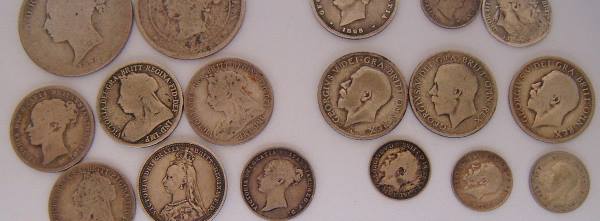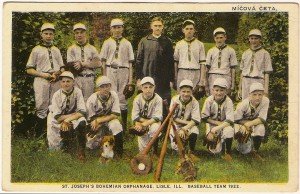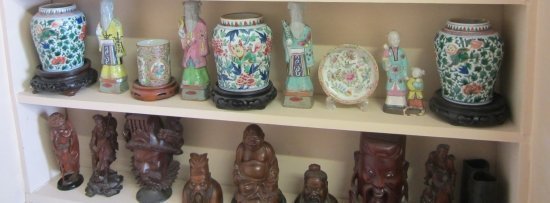In historic terms the reign of golden oak in the United States was a brief one. The rich tones of golden oak prevailed as the country’s most adorned and most desired furniture generally during the period from the 1880s to the 1920s. Thanks in a large part to the emergence of the mail-order catalog and advancement of rail transportation, it was ultimately fashionable in major cities as well as remote towns.
There were other factors as well. One was the rise of the working class in America and its interest in furniture that was attractive yet sturdy and enduring.
Toward the end of the 19th century the so-called oak period saw an “emphasis upon strong unbreakable furniture,” noted Peter Blundell in the book The Marketplace Guide to Oak Furniture, “quite contrary to the fussy fragility of a lot of the Victorian furnishings” of the time.
Certainly oak itself had been used literally for centuries in furniture made in Europe before it reached its glory days in America. During the 15th, 16th, and 17th centuries oak was used extensively in England. Craftsmen there could select from two main types of oak, one referred to as live oak and the other known by some as swamp oak. Live oak was described as having a rather elegant, brown color with an accompanying fine grain. Meanwhile, swamp oak was said to bear a long grain and be similar in appearance to American ash wood.
In America early settlers sometimes followed the European tradition of selecting oak for household furniture. Selections in this country included a reddish oak, and the heavier less brittle white oak. Fortunately oak, especially white oak, was very plentiful in the eastern part of the country. And as migration continued, it was equally plentiful in the Midwest.
Moreover the white oak in American forests was found to be far more workable in crafting furniture than the European varieties. Most all of the oak could be steamed and then bent into a particular shape, and than clamped to hold it in place. But American white oak was much easier to turn and carve, resulting in more impressive results.
European oak examples tended to be dark and age even darker, but American oak pieces were relative light in color and could be processed to retain a sort of golden tone.
This so-called golden oak was sometimes enhanced by adding yellow ochre pigments to the white wood and then coating it with hard orange shellac. Later it was polished down to a rather dull finish.
By contrast fumed oak was more of a medium brown in color. Processing it involved use of a water and ammonia solution, a two-day curing process, and a certain amount of lacquering.
Golden oak and fumed oak were only two of the options available during the glory days of oak furniture. Slight variations were offered under various other titles including the delicate gray of weathered oak and a shaded, spray-finished antique oak. Some mail-order catalogs even offered a highly polished “piano finish” oak with an exceptionally high gloss coating.
Oak furniture in general, and golden oak furniture in particular had exploded into a very big business by the 1880s in the United States. As previously mention it was plentiful in some parts of the country and American industry now was capable of significant production.
The Midwest was especially suited for such advancement. Furniture production centers loomed in Chicago, Cincinnati, and in Grand Rapids, Mich. By the end of the 1880s the oak furniture business was certainly booming. Cincinnati alone had nearly 150 factories, which employed more than 5,000 workers in furniture manufacturing. At Grand Rapids, factories there operated 12 hours a day to meet the consumer demand.
Oak furniture fashions were changing at remarkable speeds. The leading factories were introducing new lines of oak furnishings nearly every six months, a marketing technique never before seen in furniture production.
Suddenly too, was the availability of more ornate oak furniture at more reasonable rates. Decades earlier only the very wealthy could afford handsomely carved pieces. But with machinery of the 1880s furniture makers could add ornamentation to oak selections at practically the same cost that plain wood furnishings would have been earlier.
As for the household the choices were almost endless as well, from a child’s small crib right on up to the 71/2-foot tall wardrobe. Late 1880s catalogs offered not just tables, but fancy tables, office tables, parlor tables, ornamental tables, and more. A desk was not just a desk, but was instead a library desk, parlor desk, double desk, or a high or low roll curtain (roll top) desk. The “solid golden oak” library table, for example, was typically about 50 inches wide and retailed for around $20.
Three-drawer oak dressers were available with a choice of French or German bevel glass mirrors. Dressers, like nearly all other oak pieces of the era, were of solid wood except for a double-deck effect at the top, which included a hollow frame immediately beneath the solid wood top.
Busy factories also excelled at the production of large oak sideboards for the stylish dining room. These massive structures were generally less elaborate than earlier Victorian sideboards, but remained very distinguished. The best, “made of the finest quarter-sawed oak,” usually sold in the $30 range by the early 1890s.
Oak bookcases were striking as well. Just as reading and the accumulation of books grew in popularity during the latter 19th century, so did a place to store them. The 1894 Montgomery Ward catalog featured a number of oak bookcases including a revolving model made by the John Danner Company of Canton, Ohio. Danner’s Revolving Bookcase could hold all 32 volumes of the American Cylopedia. The three-tier version was said to be made to accommodate 70 to 90 volumes of average size.
During the 1890s Montgomery Ward’s catalogs, and those published by Sears, Roebuck & Co., and Canada’s Eaton’s all offered lavish assortments of oak furniture including huge extension tables. Often the large, round tables had elegantly carved claw feet at their base. And without exception they were hefty, the weight of a 10foot table was usually around 175 pounds. Elsewhere mail-order customers could select from rockers, hall trees, washstands, jardiniere stands, dining room chairs, buffets, china cabinets, dressers, and even filing cabinets – all in glorious and abundant oak.
Back in Grand Rapids nearly 40 factories were operating at extended hours to process regional oak timber into refined oak furniture. The community’s population had grown from a mere 16,000 in the 1870s to nearly 50,000 in the 1890s.
As the “new” 20th century progressed the glory golden oak and other oak began to decline. For one thing the quantity of forests laden with oak began to dwindle. As supply tightened, pieces gradually went from being solid oak to mostly oak with use of oak veneers on panel doors, door fronts, and some side panels. Toward the end of the era, large sections of lesser woods were substituted for true oak and stained to promote an oak grain appearance.
The great glory of golden oak, however, was never duplicated.




